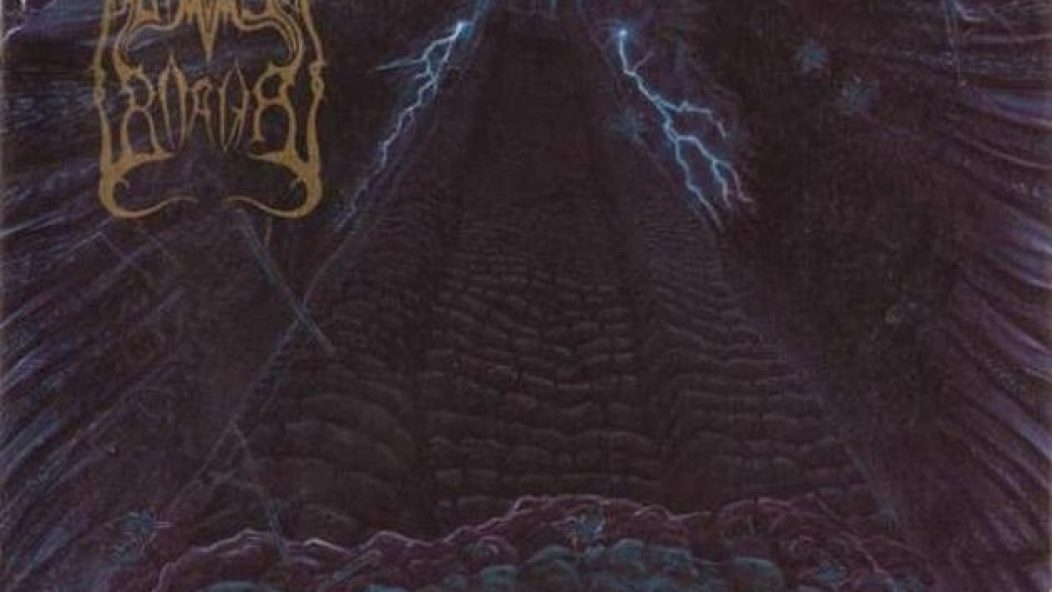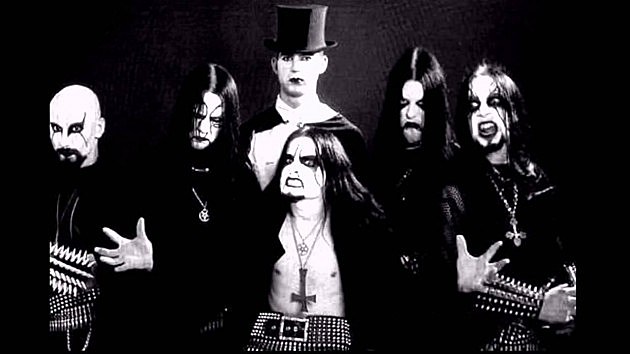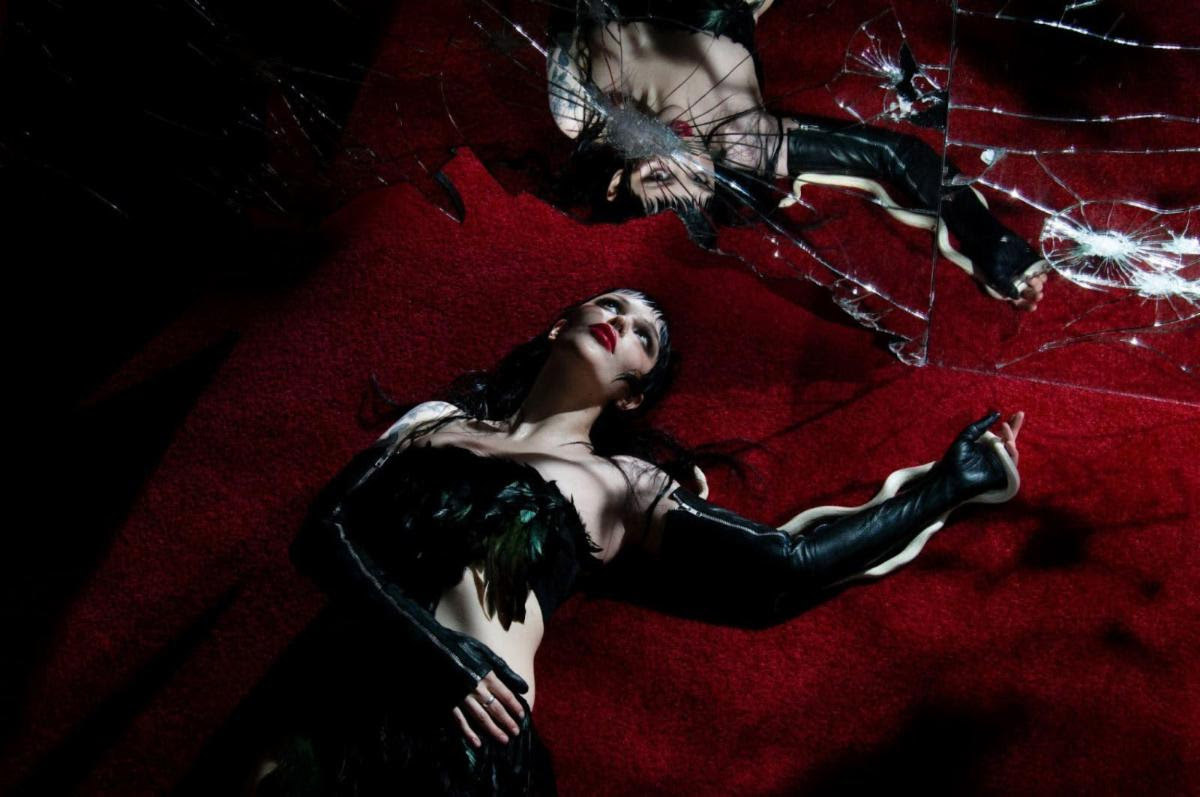
Dimmu Borgir's Stormblast Turns 20
…
This site has posted about plenty of stuff that’s heavy metal kryptonite. We’ve covered djent, deathcore, nu metal, and the New Wave of American Heavy Metal. Today’s flavor of kryptonite is symphonic black metal, because Dimmu Borgir’s Stormblåst turns 20 today.
Here’s a picture of the band at that time:

…
A couple of notes:
- The photo’s not actually in the Stormblåst CD booklet,
- But it seems to be from around that time, and in any case, it’s funny and illustrative enough to serve my purposes,
- The Bald Guy is not in the band, he’s not Galder, I don’t know who he is, but I have a theory.
Look at that photo while listening to Stormblåst, and a lot of things about the record will start making sense. (Ignore Bald Guy.) Everyone is mugging it up, making ferocious or grim black metal faces, and in the back you’ve got Stian Aarstad, the keyboardist, wearing a top hat and a cape.
Aarsted does not fit in with his bandmates, but he’s what makes Stormblåst work.
That’s the raw cognitive dissonance of Dimmu Borgir reflected in the photo above: Aarstad in his top hat, sticking out like a sore thumb and exerting a calming, non-metallic influence on the proceedings, just as his piano and synthesizer lines stick out above the music, occasionally dominating it. Meanwhile the rest of the band plays it all classic black metal style, blasting and tremolo strumming away. Second wave black metal hallmarks are present, such as rapid tremolo picking with slow chord changes and a near-total lack of staccato palm muting. Norsecore, this is not. Shagrath laid down some particularly savage vocals–he would not sound that good again in the studio for years afterwards.
Fire up the album, and the first thing you’ll hear is Aarstad’s keys. You’ll hear nothing else until 1:32 into “Alt lys er svunnet hen,” at which point the rest of the band comes in. At 2:22, Shagrath cuts loose with a savage shriek. The rest of the song follows a rough formula that will repeat through the album: Stately mid-tempo sections slathered with symphonics and fast sections where Aarstad is left in the background adding some simple atmospherics. “Broderskapets Ring” dispenses with the fast parts but throws in a classic Stian piano line and floats along instead. “Nar Sjelen hentes til helvete” flips back in the other direction with speed, but brakes suddenly in the middle for an extended piano solo. The credits show Shagrath and/or Silenoz as writing all of the music, but there’s no way they wrote that piano part. Same with the piano solo in the title track; the parts are too articulate for anyone other than Aarstad–who reportedly only listened to classical music before joining the band, never metal–to have written them.
Of course, technically Aarstad didn’t write some of his contributions. A 7-minute instrumental, “Sorgens kammers“, was lifted entirely from the title music of an Amiga game called Agony. The beginning of “Alt lys er…” was also pilfered, in this case from a Magnum song called “Sacred Hour“.
Stormblåst’s recording needed to balance Stian’s contributions against the rest of the band, and it succeeds, if awkwardly so. At a time when black metal reveled in lo-fi obscuration and raggedy treble, Stormblåst was tastefully and restrainedly mixed, balancing when needed and highlighting as necessary. “Antikrist”’s opening, for instance, has a bassline that the mixer properly pushed up audibility. The guitar tone, though, is smooth and heavily mid-range, with none of the jagged crunch of most black metal recordings.
Later on, the band would re-record Stormblåst with Peter Tagtgren in Studio Abyss and entirely miss the point, noting that originally they “didn’t realize we could have four rhythm guitars instead of two . . .” But it wasn’t just the band themselves that missed the point. Looking at Dimmu Borgir’s Metal Archives page, only two of their records receive an average grade above passing: Enthrone Darkness Triumphant, and the re-recording of Stormblåst. The original version has the third highest rating, right behind Enthrone and the redo.
How could such a relatively mellow and instrumentally rich record succeed in a reviled discography dominated by thrash riffing doused with aggro symphonics? Stormblåst didn’t vault the band to stardom. It sold well enough to draw Nuclear Blast Records’ attention and therefore money, but according to the band, the label that released Stormblåst, Cacophonous Records, performed so poorly that they were going to jump ship no matter what. It just so happened that Nuclear Blast waved around the most benjamins.
The answer to Stormblåst’s relatively warm reception is goes beyond the strong songs and the abnormal but excellent production. It’s one of the earliest symphonic black metal records, probably one of the first 25 or so to be released. It’s symphonic black metal O.G. It’s easy to forget this now, but looking back, Stormblåst was better than most of the competition even as it took considerable artistic risks. Having Stian Aarstad in the band was controversial in the mid-’90s, at a time when black metal represented either the last or second to last point in history where guitar based music both felt and was actually dangerous. It took balls and vision to bring in top-hatted classical music fan/dork and have him plink and tinkle away over mellow black metal riffs. I think people have responded to that, albeit unconsciously, even if they prefer the aggressive modernized version. It makes sense considering that Dimmu got famous for how they sounded after Stormblåst. For All Tid, which is Stormblåst’s shitpile predecessor, has a similarly high rating, and I think it’s because of that same authenticity or perceived authenticity.
While the record does well in Dimmu Borgir’s discography and is a personal favorite, it represented the last moments of Dimmu Borgir as a black metal band. The dissonance in that band photo intensified with the following record, Enthrone Darkness Triumphant, which kicked off Dimmu Borgir’s infamous three word album-title phase. They found something to like in fusing thrash and black/death riffing with keyboards, and then did so. The terminus of this path was Silenoz looking like a flour-dusted Jack Sparrow, Shagrath looking like a flour-dusted Queen Amidala, and Uncle Lester looking like a flour-dusted Uncle Lester. It’s thin evidence, but they did stop writing lyrics in Norwegian because they thought it would help sell more albums.
Either way, more bombast and more aggression would eventually be the order of things, to the point where they would utilize an actual orchestra. By that point though Aarstad had left and was replaced by a never flour-dusted Mustis, whose contributions were far less complex. Before that though, Shagrath, Aarstad and co. were Dimmu Borgir, O.G. symphonic black metal band with artistic aspirations, and Stormblåst was their A-game.
…
…











